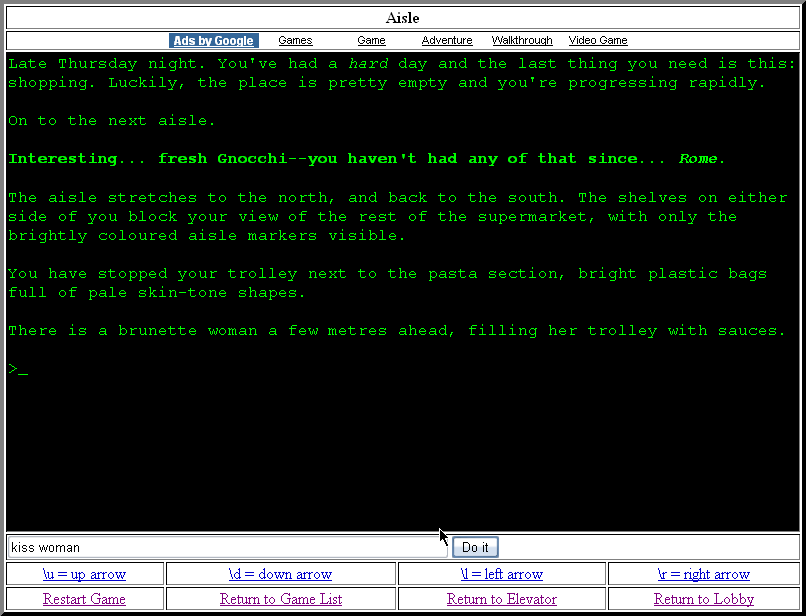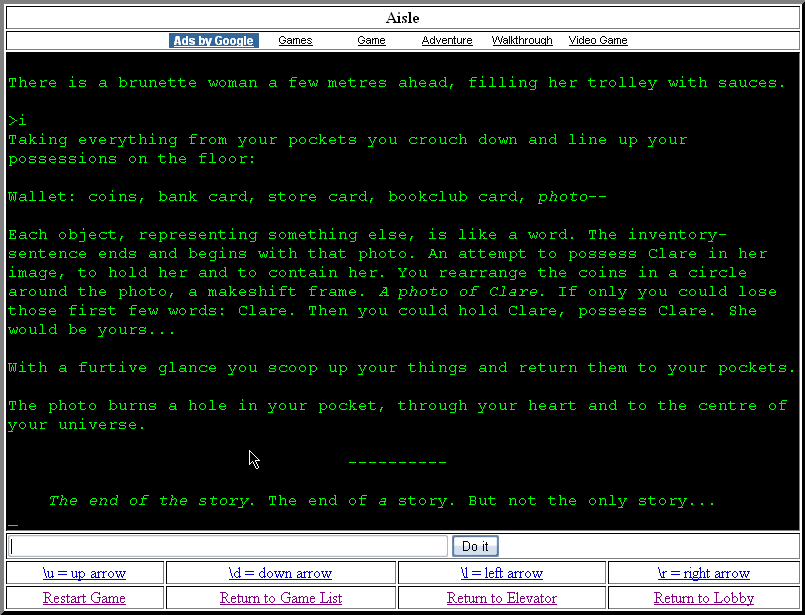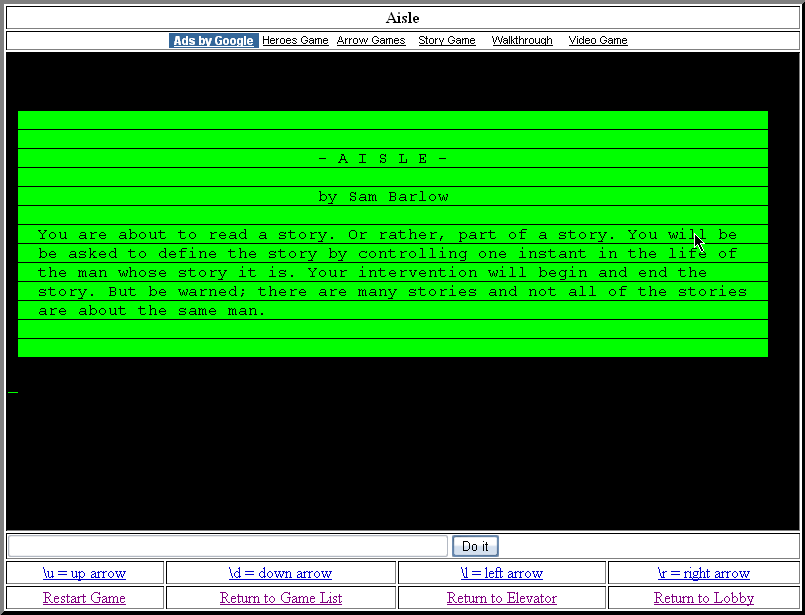Retro Replay Review
Gameplay
Aisle challenges traditional adventure game conventions by restricting the player to a single meaningful action per playthrough. Rather than wandering through a virtual world and accumulating items or solving multi-step puzzles, you’re dropped into the Italian foods aisle of a supermarket and asked to choose one interaction. That one choice triggers a short, self-contained micro-narrative that ends as abruptly as it begins.
This structure removes any possibility of failure or “wrong” moves—every selection simply unlocks another brief vignette. The real game becomes a test of curiosity and pattern recognition: what actions have you tried, and which ones remain to be discovered? Collecting all 136 endings transforms the experience from a one-off experiment into a compulsive hunt for narrative fragments.
By eliminating complex inventory systems, branching dialogue trees, and hidden key items, Aisle keeps the focus squarely on the psychology of decision-making. Each choice you make feels weighty because you know it will irrevocably define that session’s story. The gameplay loop is minimalist but surprisingly addictive for players who enjoy completionist drives and piecing together overarching themes from disparate fragments.
Of course, this streamlined approach will not satisfy those looking for deep puzzle mechanics or strategic gameplay. But if your idea of adventure is uncovering human stories through small, evocative moments, Aisle offers a fresh, almost meditative take on interactive fiction.
Graphics
As a text-based interactive fiction title, Aisle does not rely on traditional visuals or high-fidelity 3D environments. Instead, it presents a clean, text-only interface reminiscent of early computer adventure games. There are no pixel art backdrops or character portraits: all imagery lives in the prose itself.
This bare-bones presentation may initially strike some players as underwhelming, especially if you’re accustomed to modern graphical adventures. However, the minimalist interface directs your attention entirely to the narrative possibilities. There are no flashy visual distractions—every word on the screen carries purpose and atmosphere.
The game’s typography and layout are functional and readable across a variety of devices, from desktops to mobile phones. Simple prompts guide you through input, while brief pauses and on-screen transitions underscore the sense that each playthrough is a fleeting, precious moment. In this context, the “graphics” lie in the spaces between paragraphs, where your imagination fills in the details of the supermarket’s fluorescent lights and the protagonist’s state of mind.
Ultimately, if you judge a game by its visual fidelity, Aisle may feel austere. But if you appreciate evocative writing and an uncluttered presentation, the stripped-down aesthetic elegantly supports the title’s experimental design.
Story
At its core, Aisle is a mosaic of 136 flash-fiction vignettes. Each micro-narrative is triggered by a single, often mundane action—reaching for a particular pasta shape, checking an expiration date, or simply standing in silence. What emerges is an astonishing variety of memories and emotional snapshots, suggesting a complex backstory without revealing it all at once.
The game subverts the “read-the-designer’s-mind” puzzle trope by instead asking you to read the player’s mind. Which action feels logical? Which seems absurd? Every choice uncovers a different facet of the protagonist’s life: regrets, long-lost loves, brief triumphs, and small regrets. In this way, the supermarket aisle becomes a metaphorical crossroads of memory.
This fractured narrative approach excels at provoking reflection rather than delivering a single, cohesive plot. Players piece together recurring motifs—family meals, missed opportunities, fleeting moments of joy—from seemingly unrelated scenes. The result is a patchwork story that feels deeply personal yet universally resonant, as each ending casts fresh light on the man you’re briefly inhabiting.
If you prefer linear storytelling with clear beginnings, middles, and ends, Aisle may feel confusing or incomplete. But for those who relish narrative experimentation and enjoy assembling meaning from shards of text, the game offers a powerful and poetic journey.
Overall Experience
Aisle is not for every gamer. There are no epic boss battles, no sprawling worlds to explore, and no inventory of items to collect. Instead, it offers 136 fleeting, text-only experiences that invite you to consider how a single choice can open a window into someone’s life. If you approach the game expecting a conventional adventure, you may walk away disappointed.
Yet for players who delight in interactive fiction’s potential to evoke emotions and ideas with minimal interactivity, Aisle stands out as a bold experiment. The game transforms the supermarket aisle into a stage for introspection, turning what could be a dull setting into a crucible of memory. Replayability hinges on your desire to unlock every ending, making it as much a narrative puzzle as a story-driven experience.
Technically accessible and thematically ambitious, Aisle demonstrates how constraints can fuel creativity. By limiting you to one move per session, the designer amplifies the impact of each choice and each story fragment. For anyone curious about the boundaries of interactive storytelling, this title is an intriguing detour from the beaten path.
In the end, Aisle offers a compact yet surprisingly profound journey. Whether you play it for a handful of vignettes or spend hours hunting down every ending, you’ll come away with a renewed appreciation for how much narrative power can fit into a single, well-chosen moment.
 Retro Replay Retro Replay gaming reviews, news, emulation, geek stuff and more!
Retro Replay Retro Replay gaming reviews, news, emulation, geek stuff and more!









Reviews
There are no reviews yet.